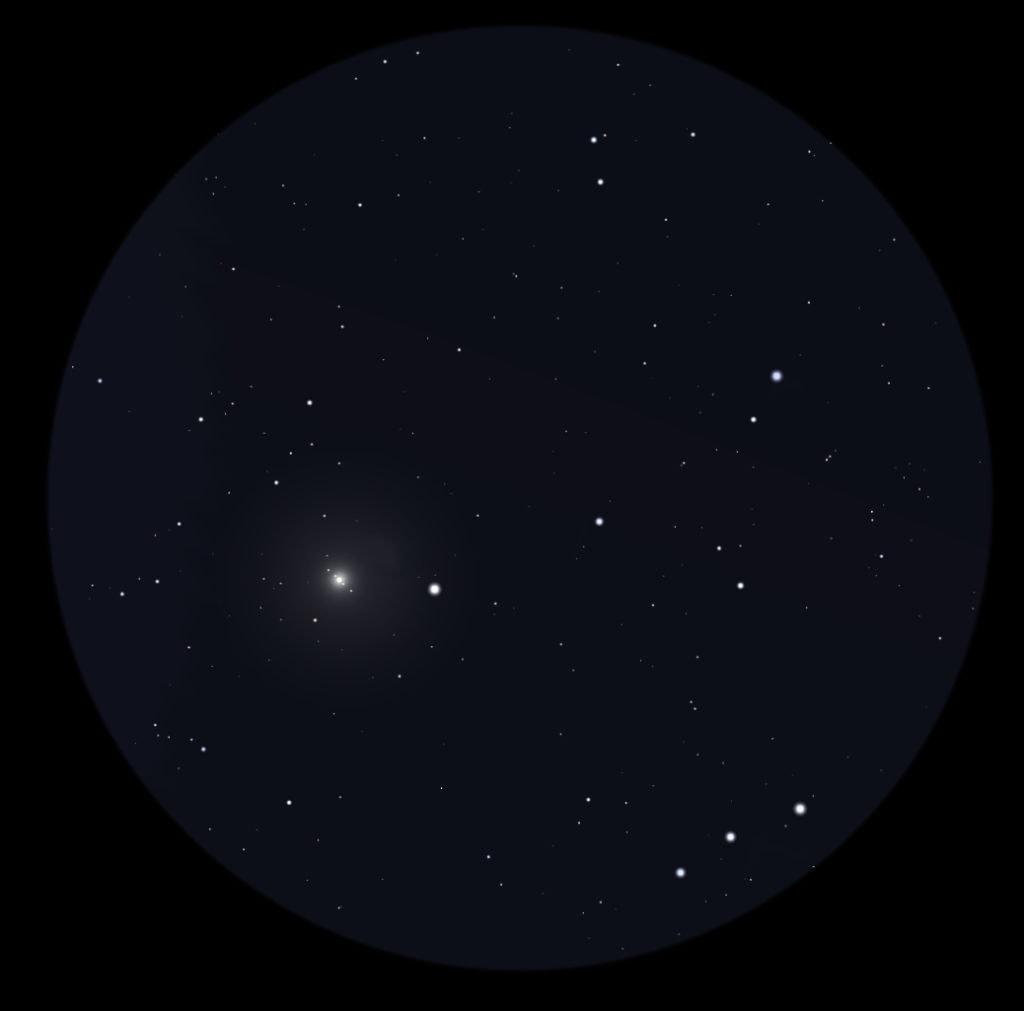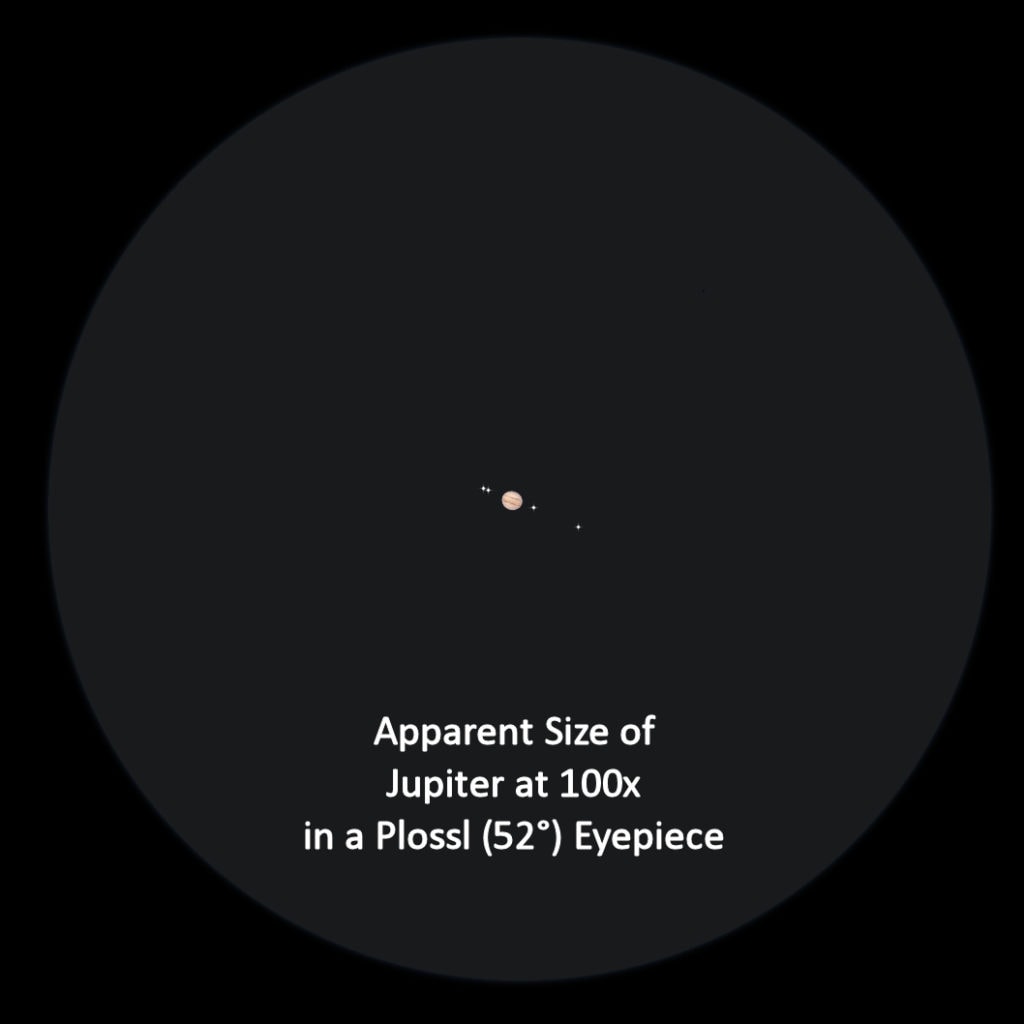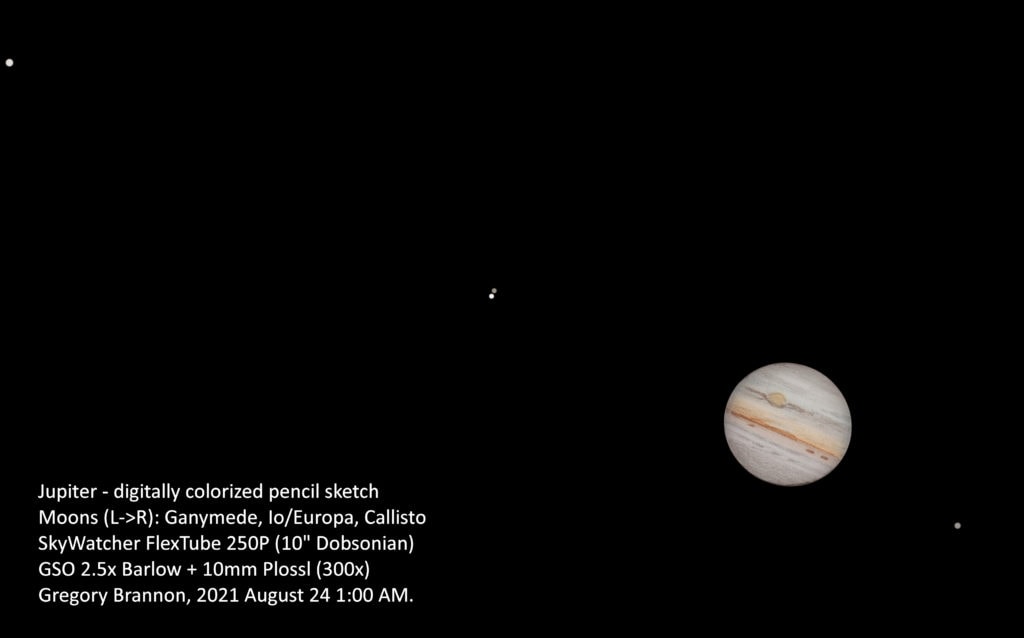In this article, we’ll go over how to find Jupiter with the naked eye, as well as how to get the most out of seeing Jupiter using a telescope. The giant planet Jupiter is one of the easiest planets to find and observe in the solar system.
A Quick-Start Guide to Observing Jupiter
If you already know where Jupiter is, or you know how to find it with an app, go ahead and just point your telescope at it. Center it on the finderscope. Use a low magnification, long focal length eyepiece to find and center the object. It will appear as a fairly small, bright dot. You may then increase the magnification with a shorter focal length eyepiece. It will still look pretty small, even at higher magnification. Look for the moons, which appear as four stars, kind of in a line with Jupiter’s equatorial plane. Jupiter also has two faint dark stripes, or “cloud bands”, which run parallel to the equator.
If you don’t know where Jupiter is, and you’d like a little more guidance on what to look for on the planet, read on.
What is Jupiter?
Jupiter is a gas giant—a planet made mostly of hydrogen and helium. Jupiter is 139,900 km across, or 11 times wider than the Earth and 318 times more massive. It’s called a “gas” giant because those are gases on Earth, but gas giants like Jupiter and Saturn are mostly made of extremely hot, extremely high-pressure liquid hydrogen with a cooler hydrogen-helium atmosphere. At the center is a massive, hot, icy core. But there is no surface–Jupiter’s layers sort of smoothly blend into one another. When we look at Jupiter with a telescope, the part we see is mostly ice-crystal clouds made of ammonia (white) and ammonium hydrosulfide (brown) ices.
Jupiter changes its appearance over time. The overall structure of cloud belts remains the same, but the belts can change color or width. Storms can grow, merge, and change color. These changes can occur over timescales of months, years, or decades.
Jupiter’s day length is very short. It rotates on its axis once every 9 hours, 55 minutes, and 30 seconds. So it takes roughly 5 hours for a feature on one edge of Jupiter to rotate across to the other edge, or just 2.5 hours to go from the edge to the middle of the planet. Different features may be seen by waiting a short time, and you may notice the rotation when observing at high power for even as little as 15 minutes.
Jupiter orbits the Sun every 11 years, 10 months, and 10 days, at a distance of 778 million kilometers. This distance is so huge that it’s basically worthless if you want to get an idea of the scale of the solar system. More useful when thinking about the solar system is to set the distance between the Earth and the Sun equal to 1 au (Astronomical Unit). Using this vast distance as a yardstick, Jupiter’s distance from the Sun is 5.2 au. Jupiter goes between about 4.2 au and 6.2 au away from the Earth, depending upon the relative position of the two planets as they circle the Sun.
Jupiter’s Satellites
Jupiter has 80 known natural satellites (‘moons’), but only four are big enough to be seen by amateur observers. These are the Galilean satellites: The Moon-sized rocky planets Io and Europa, and Mercury-sized ice-balls Ganymede and Callisto. Each of these satellites is a planet in its own right. They are not technically planets as they do not orbit the Sun, but they’re round, world-like objects. Io is covered in volcanoes, Europa has an icy crust covering a global ocean kept warm by submerged volcanoes, Ganymede is an ice ball bigger than Mercury with both impact craters and icy tectonic plates, and internally-cold Callisto has more craters than any other solar system world.
You won’t be able to see the moons as more than points of light in a telescope, however. The moons all appear close to being in a line along the equatorial plane of Jupiter because they all orbit in circles within Jupiter’s equatorial plane. Since we’re looking at that disk of concentric orbits edge-on, they appear to be in a line. You can’t tell which moons are which from the position alone, because as they appear to move back and forth along that line, they may look closer to Jupiter than they actually are. If you pay close attention to the relative brightnesses (or size, in a big telescope) and subtle color variations, you can make educated guesses about which is which, but the only way to be sure is to look up the position of the moons in an ephemeris table or in a planetarium app.
Io, Europa, and Ganymede are in a 1:2:4 orbital resonance. Every time Ganymede completes one orbit of Jupiter, Europa will have completed two orbits, and Io will have completed four. Callisto is left out of this resonance.
| Satellite name | Orbital Period | Distance from Jupiter* |
| Io | 1 day 18 hours 27 minutes | 3.015 DJ |
| Europa | 3 days 13 hours 13 minutes | 4.797 DJ |
| Ganymede | 7 days 3 hours 40 minutes | 7.652 DJ |
| Callisto | 16 days 16 hours 30 minutes | 13.46 DJ |
Jupiter’s moons will often pass in front of the planet, casting their shadows on the planet. They may also go behind the planet, and sometimes you can see the satellite fade to black as it enters the shadow (or fade in from black as it leaves the shadow).
Jupiter features to see with your telescope
Let’s imagine zooming in on Jupiter. As we do so, we’ll see more and more of the planet’s features, and the features will be visible more clearly. If conditions and optical quality allow, we can observe features that were difficult at a lower power with more ease at a higher power. For this section, we’re assuming that we’re using good optics under good conditions; note that if you try to bring a small telescope up to 400x, it will just be dim and blurry. The highest power you should use with any telescope is equal to 50x per inch or 2x per millimeter of aperture, and you should also have a magnification equal to perhaps 1x or 1.5x per millimeter.
Jupiter will appear fairly small in the field of view of your eyepiece. It may be huge, but it’s very far away, so you’ll have to observe subtle features on a very small object with your telescope. Even at 50x, it’s barely larger than how the moon appears to your unaided eye. Observing with a telescope is a skill, and practice makes you better. Keeping a descriptive journal and sketching your observations can help you train that skill.
1x (Unaided Eye) to 6x (Small Binoculars)

Easy:
Jupiter is a bright point of light in the sky.
Moderate:
Jupiter is slightly yellowish and does not twinkle.
Hard:
Watch Jupiter over the course of several weeks or months. Compare its position with the background stars, and watch it move along its own orbit.
7x to 20x (Binoculars and Small Telescopes)

Easy:
Jupiter is a small circular disk, not a point source.
Moderate:
Jupiter has four small stars beside it in a line. These are the Galilean satellites.
Hard:
Jupiter satellite eclipses and transits. As the satellites orbit the planet, they may go in front of or behind the planet. They may appear from or disappear into the planet’s shadow, or become hidden as they go in front of the planet.
50x-100x (Small or Medium Telescopes)

Easy:
There are one or two dark stripes or “bands” running through the equatorial region of the planet.
Moderate:
A satellite may cast a shadow–a tiny black pinprick–onto Jupiter as it passes in front of it. Ganymede’s and Callisto’s shadows are easiest to spot as they are larger.
Hard:
The Great Red Spot may be glimpsed if it is well-placed as the planet rotates.
200x-400x (Medium and Large Telescopes)


Easy:
Jupiter has lots of subtle regions of cloud banding ranging from its equatorial and temperate banding to its dark gray polar hoods.
Moderate:
Jupiter has several spots–actually enormous hurricane-like storms which last anywhere from months to centuries. The longest-lasting and easiest to see is typically the Great Red Spot, on the South Equatorial Belt, but brown barges can be seen north of the North Equatorial Belt, and white ovals can sometimes be seen against the equatorial belts and the subtle temperate belts. During satellite transits, the satellite itself may be seen as a small dot on the surface. It’s often low-contrast and difficult to see compared to the dark shadow.
Hard:
Between the belts are subtle “festoons,” arcs or waves of darker structure in the pale white regions.
Seriously Advanced:
In very large telescopes (12” or more) under steady skies, very subtle surface features on Jupiter’s satellites can be glimpsed. Ganymede’s albedo features are the easiest to see due to its larger size.
Optimizing your High Magnification Viewing
See our companion article, for a full guide about how to choose the proper magnification and troubleshoot blurry images.
How to Find Jupiter in the Sky
I often point out the planets in the sky at night to passers-by. “Hey,” I’ll say, “Do you see that bright star up there? That’s not a star at all; it’s the planet Jupiter. ” They often wonder aloud, “How do you know?” The truth is I know because I’ve been following the planet for months by the time it’s well-placed enough for me to point it out in the evening. Once you have seen Jupiter once, you’ll be able to find it again pretty much right where you left it, as long as it hasn’t been too long and you’re looking at about the same time of evening. Planets move, but at least when it comes to the outer planets, they don’t move that fast.
It is important to remember that the night sky changes over the course of the day and over the course of the year. Jupiter will not always be up in the evening. Sometimes it’s up only during the early morning, sometimes it’s up only during the day and it’s almost impossible to find. Whereas the distant stars appear as fixed points, planets such as Jupiter do slowly move against the background stars.
When Jupiter is up, it is brighter than any star. Jupiter, Venus, and even Mars when it is near to the Earth, all share this aspect. When it is well-placed, Jupiter can be seen not long after sunset, usually before the stars appear.
Jupiter appears as a bright white or yellow-white star that does not twinkle. The twinkling of stars comes from atmospheric turbulence distorting a point source of light. Planets appear as tiny disks instead, so they don’t get distorted enough to flicker or twinkle. On a very steady night, even the stars do not appear to twinkle. On a turbulent enough night, the planets might twinkle slightly, but the stars will twinkle more.
If you can identify constellations, an easy way to identify Jupiter is to figure out which constellation it is in and find that constellation. Here’s a chart showing what constellation Jupiter is in during each opposition –when it is on the opposite side of the sky from the Sun, closest to Earth, and best seen.
The Table of Jupiter Oppositions for the next 10 years
| Date of Opposition | Constellation | Pointer stars during opposition. |
| 2023-November-3 | Aries | West of Taurus & Pleiades |
| 2024-December-7 | Taurus | Northeast of Aldebaran |
| 2025* | Taurus & Gemini | No opposition in 2025. |
| 2026-January-10 | Gemini | South of Pollux, high in the sky in N. Hemisphere. |
| 2027-February-11 | Leo | West of Leo asterism. Close to Mars during the opposition of both planets! |
| 2028-March-12 | Leo | South of Leo asterism. Really close to Virgo. |
| 2029-April-12 | Virgo | Close to Spica & not far from Mars during opposition. |
| 2030-May-13 | Libra | Northwest of bright red star Antares |
| 2031-June-1 | Ophiuchus | Northwest of teapot asterism. |
| 2032-July-19 | Sagittarius | East of teapot asterism. |
*Jupiter’s synodic period–or the average time between oppositions–is 398.88 days, or about 13 months. So, each year, the planet appears at opposition one month later than last year and has moved about one zodiacal constellation eastward. Since the opposition in 2024 is late in the year, there won’t be an opposition in 2025, and the next is in early 2026. Observe Jupiter early and late in the year.
When observing with a telescope, especially at higher magnification, the best time to observe Jupiter is when it is fairly high in the sky. Below about 30 degrees altitude, atmospheric dispersion can blur the image with a little bit of false color fringing, and the increased air mass means that there’s more turbulent air and seeing conditions are worse. Jupiter’s declination, a measure of its celestial latitude, determines how high it gets. When it’s in a southerly constellation, northern hemisphere observers will find that it stays pretty low in the southern sky. When it’s in a northerly constellation, northern hemisphere observers will see it very high in the sky. An easy way to figure out if it’s going to be fairly low or fairly high: if it’s at opposition in Summer, it will stay low in the sky that year. If it’s in opposition in winter, it will get very high in the sky each day/night of that year. (If you live near the equator, Jupiter’s max altitude stays high all year.)
Half a year after the opposition, Jupiter goes into superior conjunction, where it passes almost behind the Sun and is only visible during the day. Before and after this time period, it would be visible to the eye only during sunset and sunrise, and it would be somewhat dim. About 3 months before opposition, Jupiter is visible in the early morning skies. About 3 months after its opposition, it is still visible in the evening skies. During opposition, it rises at sunset and reaches its highest point in the sky at midnight. During and near to opposition, it is visible all night long.
An object is at its maximum altitude when it passes the Meridian, the line in the sky running from the North Celestial Pole, through the Zenith (the top of the sky), and down to the South Celestial Pole. At Opposition, Jupiter reaches the Meridian at midnight. 3 months after opposition, it reaches the Meridian around sunset and sets around midnight. 3 months before opposition, it rises at about midnight and reaches the meridian around sunrise.
Don’t restrict yourself to observing Jupiter only during opposition! It is worth observing virtually any time you can see it, and it’s easily visible in the evening skies for perhaps 3-5 months after opposition. (Depending upon how good your western tree-line is). It is also visible before the opposition if you stay up late or get up very early. Opposition is just when the planet appears at its largest and brightest. But unlike Venus and Mars, which get much smaller when they’re far away, we were never that close to Jupiter, to begin with, so at opposition, it’s only about 5/4ths larger than average. That’s not nothing, but it’s only a subtle change.
Apps and Resources for finding Jupiter
Several planetarium apps are available for your smartphone that can show you the sky as it appears right now, or with a time travel function to see what the sky will look like in the future. A really good free app, available on Android, desktop, and web browsers, is Stellarium. The desktop app is the most powerful version. The mobile versions are available in both free and paid versions. I use Stellarium primarily as a star map. Other planetarium apps are available that allow you to point the phone at the sky and see what’s behind it. These aren’t usually that accurate, but they point you in the right direction at least. SkEye on Android does this. SkySafari is available on Android and Apple devices and will also point you in the right direction. Planetarium apps like these also allow you to “time travel” to see what the sky will look like at a given time and date.
If you prefer not to use mobile devices while observing (which is wise!), there are other ways to figure out where the constellations are. A star atlas can show you the shape and relative position of the constellations. The book The Stars by H.A. Rey is a useful guide for observing all of the constellations.
A practical tool to figure out what constellations are up at a given time is a planisphere (plane-sphere or “Star Wheel.”) It is a round all-sky chart that allows you to dial in the date and time and see which stars are up, as well as figure out where in the sky those stars are. If you know what constellation Jupiter is in, you can use the planisphere to find that constellation, and it will be a bright star hanging around there. My favorite planisphere is The Night Sky Two-Sided Planisphere, because it splits the sky into two maps, one centered south and the other centered north, reducing distortions and increasing the map scale.
